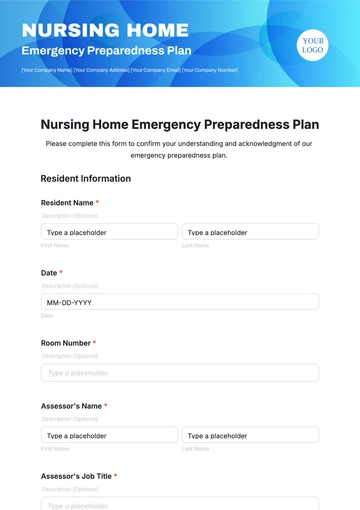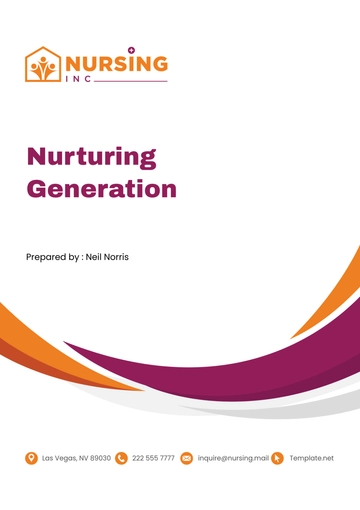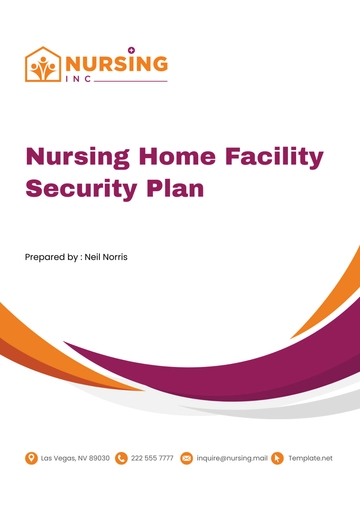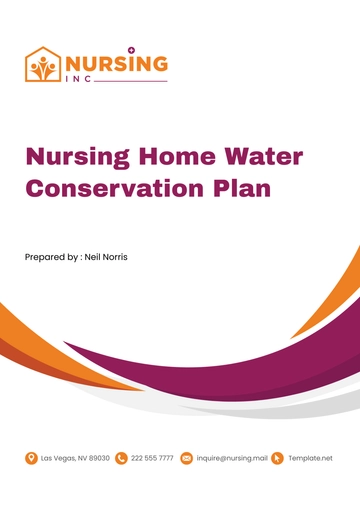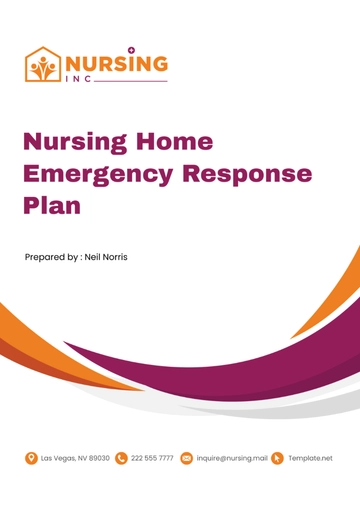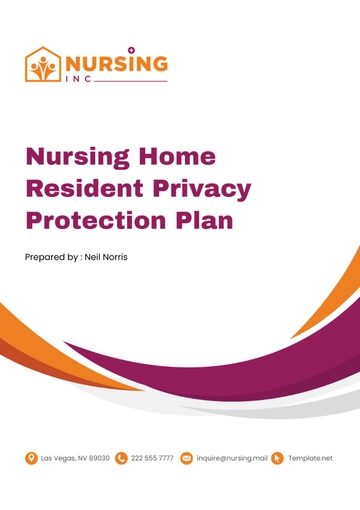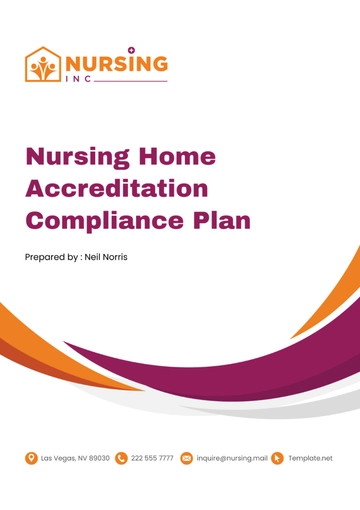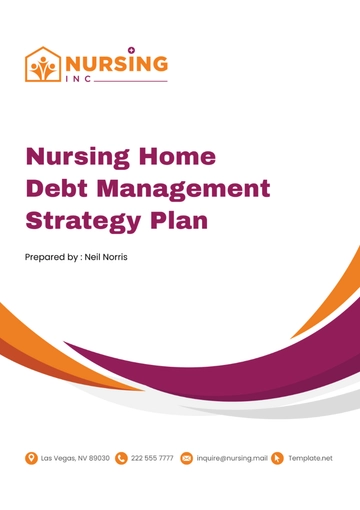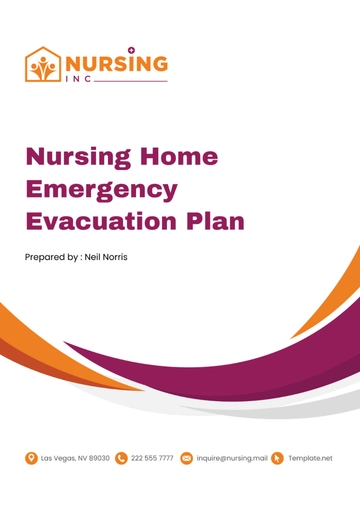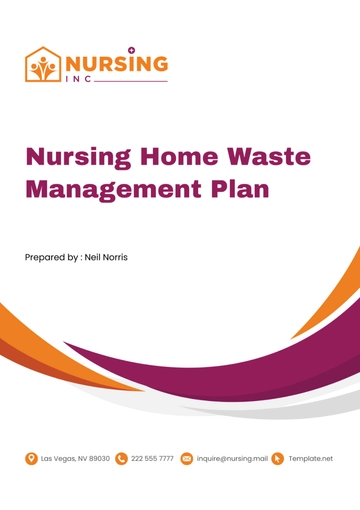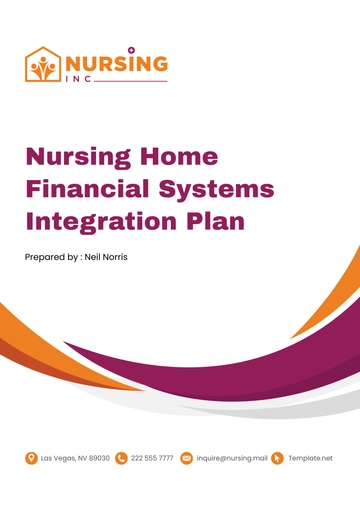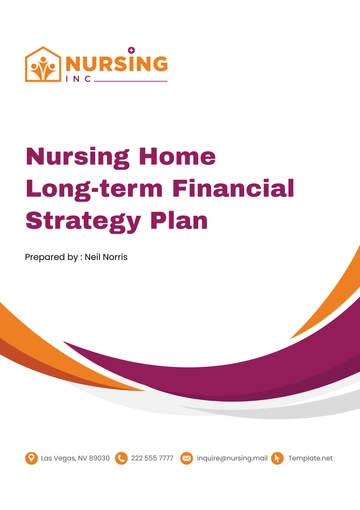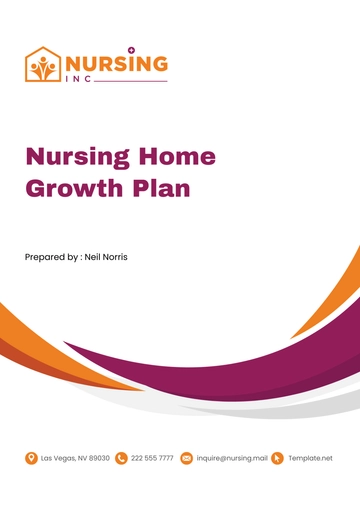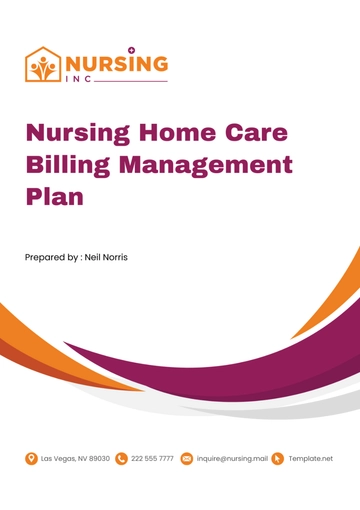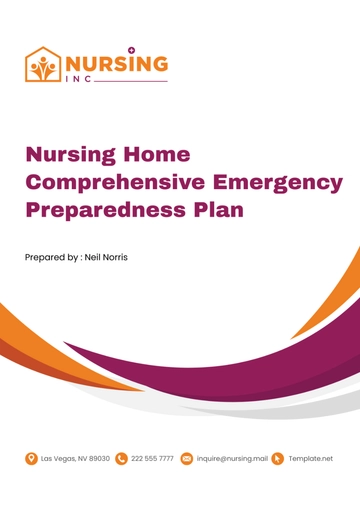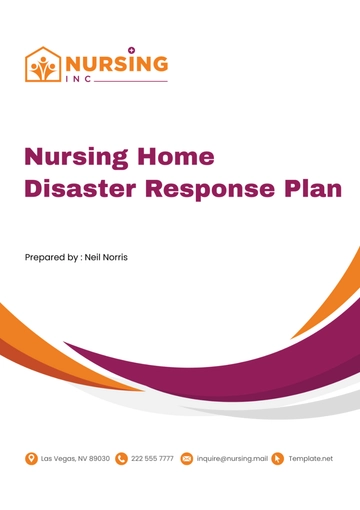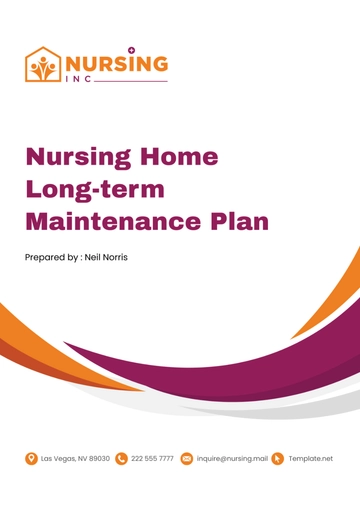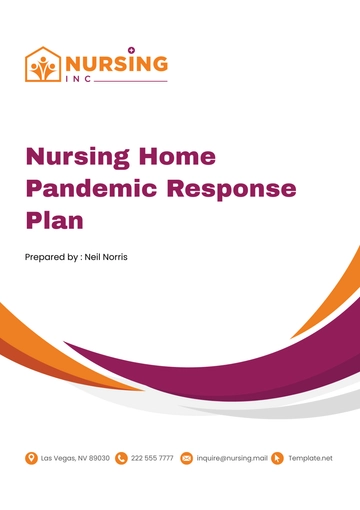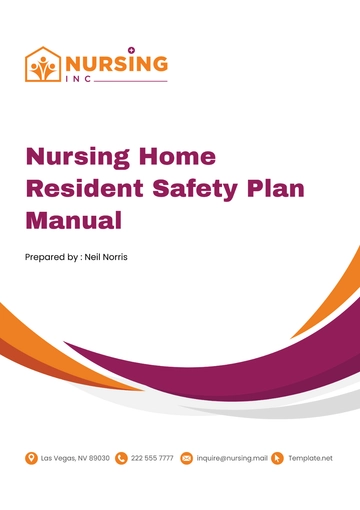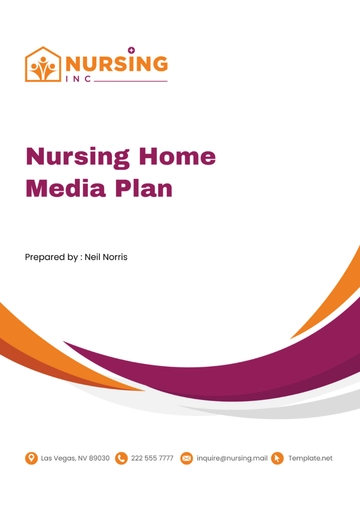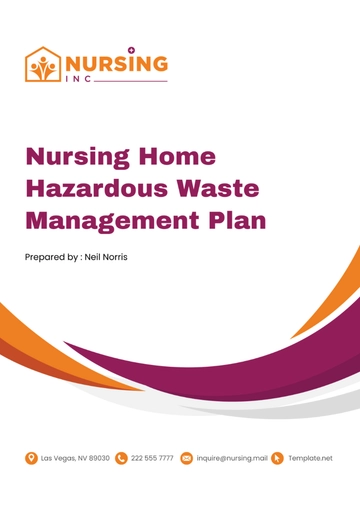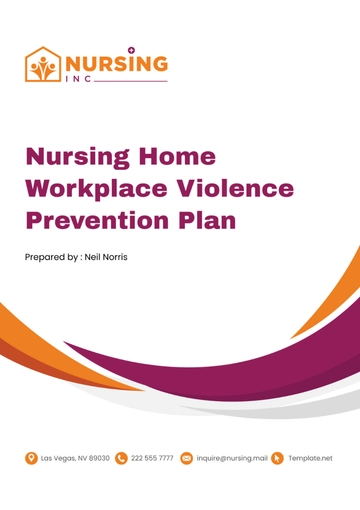Free Nursing Home Financial Plan
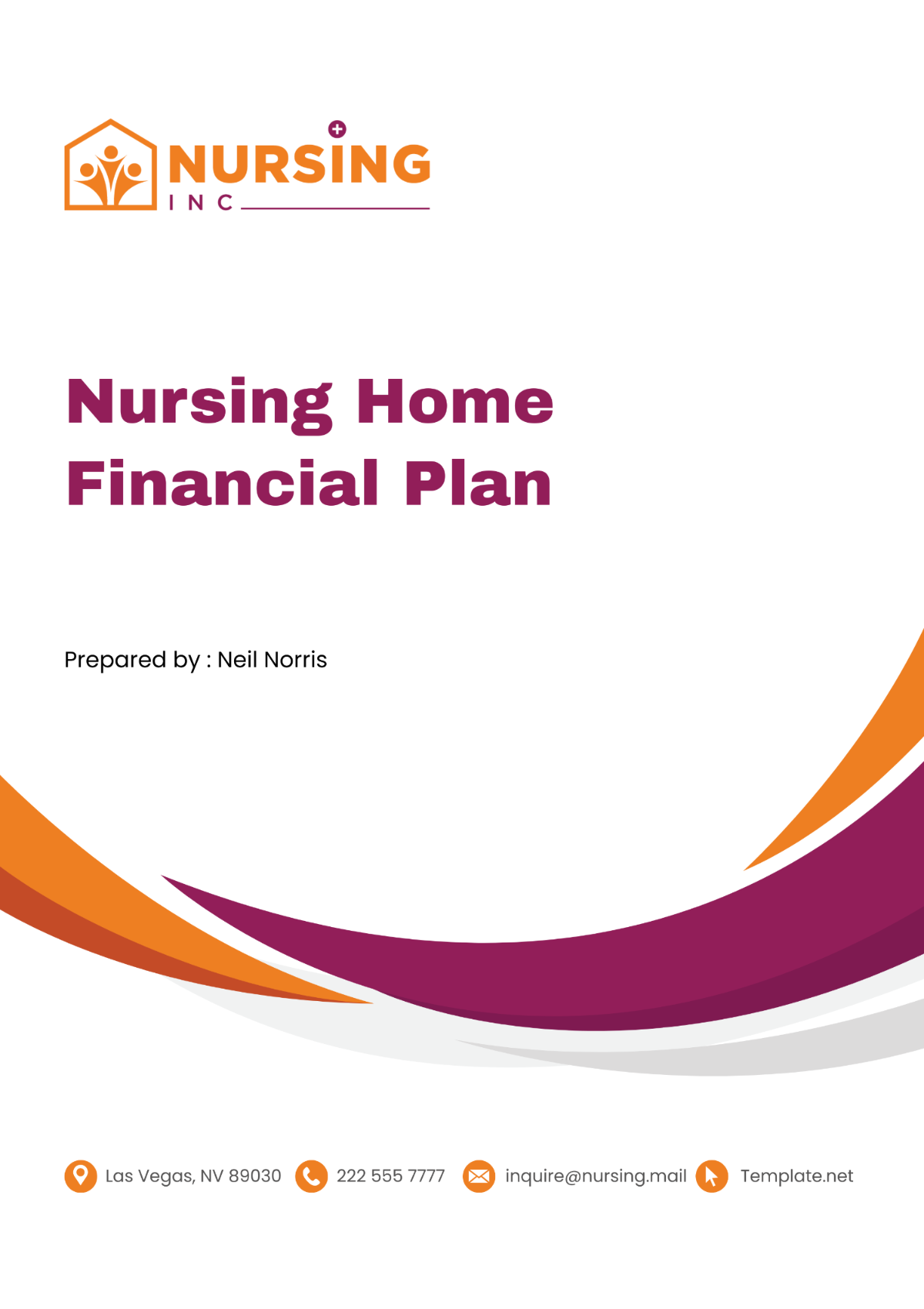
I. Executive Summary
In the evolving landscape of healthcare, [Your Company Name] stands at the forefront of providing unparalleled care within our state-of-the-art nursing home facilities. Our Executive Summary charts a course towards fiscal resilience, emphasizing the integration of innovative financial strategies that align with our core mission of delivering superior resident care. By leveraging cutting-edge technology and data analytics, we aim to optimize operational efficiencies, reduce unnecessary expenditures, and enhance revenue streams. This strategic approach ensures that [Your Company Name] remains financially robust, capable of adapting to market dynamics while maintaining the highest standards of care.
At the heart of our financial strategy is a commitment to sustainability and growth. [Your Company Name] is dedicated to reinvesting in our facilities, staff development, and resident services to foster an environment of excellence and innovation. By establishing prudent financial management practices, including rigorous budgeting processes and cost-control measures, we aim to maximize resources and ensure long-term financial health. This will enable us to expand our reach, improve resident satisfaction, and enhance the overall well-being of our community.
Understanding the importance of stakeholder engagement, [Your Company Name] prioritizes transparent and effective communication regarding our financial strategies and outcomes. Through regular reporting and open dialogue, we build trust and collaboration with our investors, staff, and the families we serve. Our financial plan is not just a blueprint for economic success; it's a commitment to the ethical stewardship of resources that upholds our dedication to excellence in care. As we move forward, [Your Company Name] remains steadfast in our mission, with a clear vision for financial sustainability that supports and elevates the lives of those in our care.
II. Resource Allocation
In our pursuit of excellence in care and operational efficiency, the Resource Allocation section of our Nursing Home Financial Plan meticulously outlines strategies for the judicious use of resources. Through a rigorous process involving audits, gap analysis, procurement planning, regular reviews, and feedback loops, we aim to ensure every dollar contributes to enhancing resident care and facility operations. This strategic allocation supports our mission to provide exceptional service while maintaining financial health.
The following tables provide a structured overview of our approach to resource allocation:
Table 1: Resource Audit and Gap Analysis
Resource Category | Current Inventory | Optimal Level | Gap Identification | Impact on Care |
|---|---|---|---|---|
Medical Supplies | 1000 units | 1500 units | 500 units | Delays in routine care |
Staffing Levels | 75 full-time staff | 90 full-time staff | 15 staff | Increased workload, potential burnout |
Equipment | 20 units | 25 units | 5 units | Longer wait times for treatment |
Technology | Basic digital records | Comprehensive care management system | Outdated system | Inefficient patient tracking and record-keeping |
Table 2: Procurement Plan
Resource Category | Required Quantity | Estimated Cost | Supplier Options | Procurement Timeline |
|---|---|---|---|---|
Medical Supplies | 500 units | $25,000 | [Supplier Names] | [MM-DD-YYYY] |
Equipment | 5 units | $50,000 | [Supplier Names] | [MM-DD-YYYY] |
Technology | 1 system upgrade | $100,000 | [Supplier Names] | [MM-DD-YYYY] |
Staff Training | 4 sessions | $10,000 | [Supplier Names] | [MM-DD-YYYY] |
Table 3: Quarterly Review and Feedback
Quarter | Review Date | Key Findings | Adjustments Made | Feedback Received | Next Steps |
|---|---|---|---|---|---|
Q1 | [MM-DD-YYYY] | Underutilization of new equipment | Training sessions for staff | Positive feedback on equipment efficiency | Monitor equipment use closely |
Q2 | [MM-DD-YYYY] | Staffing still below optimal despite hiring | Initiate additional recruitment campaign | Staff express improvement in workload management | Continue recruitment efforts |
Q3 | [MM-DD-YYYY] | Medical supplies usage higher than anticipated | Adjust procurement plan for Q4 | Requests for specific medical supply brands | Evaluate supplier contracts |
Q4 | [MM-DD-YYYY] | Technology upgrade improves care delivery | Plan next phase of tech enhancements | High satisfaction with new system | Schedule next tech upgrade review |
This detailed approach in our Resource Allocation section illustrates [Your Company Name]'s commitment to adaptive, responsive management of resources to ensure the highest standards of resident care and operational excellence. Through ongoing audits, gap analyses, and feedback-driven adjustments, we strive to maintain a seamless environment that supports the well-being of both residents and staff.
III. Budgeting and Forecasting
At [Your Company Name], our approach to budgeting and forecasting is designed to ensure financial resilience and operational excellence. By analyzing historical financial data and employing predictive analytics, we aim to identify trends and future challenges, establishing a dynamic budget that can adapt to changing circumstances. This process not only allows us to optimize our financial resources but also to identify and leverage cost-saving opportunities, ensuring we are always positioned to meet our commitments to high-quality resident care.
Table 1: Historical Financial Data Analysis
Financial Metric | FY 2048 | FY 2049 | Change (%) | Analysis Insight |
|---|---|---|---|---|
Revenue | $2,000,000 | $2,200,000 | +10% | Increase due to service expansion |
Operating Costs | $1,200,000 | $1,300,000 | +8.33% | Rise in healthcare supplies cost |
Net Profit | $800,000 | $900,000 | +12.5% | Improved operational efficiency |
Staffing Costs | $600,000 | $650,000 | +8.33% | Additional staff hiring |
Technology Investment | $100,000 | $150,000 | +50% | Upgrade in patient management system |
Table 2: Future Financial Challenges and Opportunities
Challenge/Opportunity | Impact Analysis | Strategic Response |
|---|---|---|
Rising healthcare costs | Increase in operating costs | Negotiate better rates with suppliers |
Regulatory changes | Potential increase in compliance costs | Invest in staff training and technology |
Economic downturn | Possible decrease in funding sources | Diversify revenue streams |
Technological advancements | Opportunity for operational efficiency | Allocate budget for tech upgrades |
Table 3: Budget Planning and Adjustments
Budget Category | Initial Budget | Adjusted Budget | Reason for Adjustment | Expected Outcome |
|---|---|---|---|---|
Operating Costs | $1,300,000 | $1,250,000 | Identified cost-saving in supply chain | Reduce expenses, maintain care quality |
Staff Development | $50,000 | $75,000 | Increased focus on staff training | Improve staff satisfaction and efficiency |
Technology Investment | $150,000 | $200,000 | Accelerated tech adoption | Enhance operational efficiency |
Marketing | $100,000 | $120,000 | Expand reach to new clients | Increase in resident admissions |
This comprehensive approach to Budgeting and Forecasting allows [Your Company Name] to navigate financial complexities with agility and foresight. Through continuous review and adjustment of our financial plans, we remain committed to our mission of delivering superior care while ensuring the sustainable growth and financial health of our organization.
IV. Revenue Enhancement
[Your Company Name]'s strategic vision for financial sustainability includes a keen focus on enhancing revenue streams. This entails a multifaceted approach that includes diversifying our service offerings, harnessing efficiencies, and identifying innovative activities that generate income. By expanding our market presence and promoting value-added services, we aim to not only increase our income but also enhance the quality of care and life for our residents, ensuring our position as a leader in the healthcare sector.
Table 1: Service Diversification
Service Offering | Description | Expected Revenue Increase | Implementation Timeline |
|---|---|---|---|
Memory Care Program | Specialized care for dementia patients | 15% | Q2 [Year] |
Rehabilitative Services | Physical, occupational, speech therapy | 10% | Q3 [Year] |
Wellness and Fitness Programs | On-site fitness classes, nutrition counseling | 5% | Q1 [Year] |
Telehealth Services | Remote medical consultations | 20% | Q4 [Year] |
Table 2: Operational Efficiency Improvements
Operational Area | Efficiency Measure | Cost Saving Estimate | Revenue Impact |
|---|---|---|---|
Supply Management | Bulk purchasing and supplier negotiations | 5% of operating costs | Increased profit margins |
Energy Use | Investment in energy-efficient systems | 3% of operating costs | Reduction in overhead costs |
Staff Scheduling | Use of staffing software to optimize shifts | 2% of labor costs | Lower labor costs, improved service |
Administrative Tasks | Automation of routine tasks | 4% of operating costs | More time for value-added services |
Table 3: Innovative Revenue-Generating Activities
Activity | Description | Expected Revenue Increase | Implementation Timeline |
|---|---|---|---|
Community Health Workshops | Health education sessions for the local community | 5% | Q2 [Year] |
Facility Rental for Events | Renting out space for community events | 3% | Q3 [Year] |
Partnered Wellness Programs | Collaborations with wellness brands | 7% | Q4 [Year] |
Specialty Care Services | Services like bariatric care, ventilator care | 10% | Q1 [Year] |
Table 4: Market Expansion and Value-Added Services
Strategy | Description | Expected Revenue Increase | Implementation Timeline |
|---|---|---|---|
Online Marketing | Enhanced digital presence to reach wider audience | 10% | Ongoing |
Referral Programs | Incentives for referrals from residents and their families | 5% | Q2 [Year] |
Upselling Services | Additional premium services for residents | 8% | Q3 [Year] |
Strategic Partnerships | Collaborations with healthcare providers | 12% | Q4 [Year] |
This comprehensive Revenue Enhancement strategy underscores [Your Company Name]'s commitment to financial innovation and growth. By expanding our services, improving operational efficiencies, and introducing new income-generating activities, we set the stage for a future where our financial strength enables us to provide even more outstanding care to our residents.
V. Financial Compliance
[Your Company Name] upholds the highest standards of financial compliance, recognizing its pivotal role in maintaining our reputation and operational integrity. Our comprehensive strategy includes appointing dedicated compliance officers, ensuring all team members are well-versed in compliance matters, and establishing robust systems for identifying and rectifying non-compliance issues. By proactively updating our compliance practices, we fortify our commitment to transparency and accountability.
Table 1: Compliance Officer Role and Audits
Responsibility | Description | Frequency | Expected Outcome |
|---|---|---|---|
Regular Audits | Conduct financial audits to ensure adherence to all regulations | Quarterly | Identify and address compliance risks |
Staff Training | Oversee financial compliance training for all staff members | Bi-annually | Ensure staff understand and adhere to financial regulations |
Reporting Mechanism | Develop and manage a system for reporting non-compliance issues | Ongoing | Facilitate timely identification of compliance issues |
Table 2: Staff Training on Financial Compliance
Training Topic | Description | Target Audience | Training Frequency |
|---|---|---|---|
Anti-Fraud Measures | Educating staff on recognizing and preventing fraud | All staff | Annually |
Financial Documentation | Proper procedures for financial record-keeping | Finance staff | Semi-annually |
Regulatory Updates | Updates on healthcare financial regulations | All staff | As regulations change |
Table 3: Non-Compliance Issue Flagging System
System Component | Description | Implementation Detail | Monitoring Frequency |
|---|---|---|---|
Issue Reporting Tool | A digital tool for staff to report compliance issues | Integrated into internal systems | Ongoing |
Review Committee | A committee to review reported issues | Composed of compliance officer and senior management | Monthly |
Action Plan Registry | A database to track corrective measures taken | Updated after every review meeting | Quarterly |
Table 4: Corrective Measures and Compliance Updates
Identified Issue | Corrective Measure | Implementation Timeline | Review Period |
|---|---|---|---|
Inaccurate Billing | Implement a new billing verification process | 30 days from identification | Bi-annually |
Regulatory Non-Adherence | Update training materials and conduct emergency training sessions | Immediate, post-identification | Annually |
Documentation Errors | Introduce a double-check system for all financial documentation | 60 days from identification | Quarterly |
[Your Company Name]'s dedicated approach to Financial Compliance ensures that we not only meet but exceed industry standards, safeguarding our operations and reinforcing trust among our stakeholders. Through regular audits, continuous staff education, and a responsive system for managing non-compliance, we maintain a culture of integrity and accountability essential for our sustained success.
VI. Staff and Stakeholder Engagement
At [Your Company Name], we believe that our greatest asset is our people. Our Nursing Home Financial Plan is built on the foundation of inclusivity and engagement, recognizing the critical role that transparent communication and active participation play in achieving our financial objectives. By empowering our staff with knowledge and ownership of financial goals, and involving stakeholders in crucial decisions, we create a collaborative ecosystem that drives our mission forward.
Table 1: Communication Strategies
Strategy | Description | Target Audience | Frequency |
|---|---|---|---|
Financial Updates | Share comprehensive updates on financial health | All staff and stakeholders | Quarterly |
Open Forums | Host Q&A sessions on financial matters | All staff | Bi-annually |
Stakeholder Meetings | Dedicated sessions to discuss financial strategies | Key stakeholders | Annually |
Table 2: Ownership and Engagement in Financial Goals
Initiative | Description | Implementation Detail | Measurement |
|---|---|---|---|
Goal-Oriented Teams | Form teams focused on specific financial targets | Assign teams to budget management, cost savings, etc. | Achievement of financial targets |
Staff Feedback System | System for staff to suggest financial improvements | Online platform for suggestions | Number of implemented suggestions |
Table 3: Stakeholder Engagement in Financial Decisions
Method | Description | Stakeholder Group | Frequency |
|---|---|---|---|
Advisory Panels | Panels including key stakeholders to advise on financial decisions | Investors, Board Members, etc. | As needed |
Annual Financial Reports | Detailed reports outlining financial status and future plans | All stakeholders | Annually |
Stakeholder Surveys | Surveys to gather input on financial planning and performance | All stakeholders | Bi-annually |
Table 4: Reward and Incentive Schemes
Scheme | Description | Eligibility | Reward Criteria |
|---|---|---|---|
Performance Bonuses | Bonuses for staff contributing to financial efficiency | All staff | Exceeding financial targets |
Recognition Programs | Public acknowledgment of staff and teams making significant financial contributions | All staff | Innovative cost-saving measures |
Table 5: Financial Training Programs
Training Topic | Description | Target Audience | Frequency |
|---|---|---|---|
Budget Management | Training on effective budget management techniques | All staff, especially department heads | Annually |
Financial Literacy | Courses on basic financial concepts and reporting | All staff | Semi-annually |
Cost-Saving Best Practices | Workshops on identifying and implementing cost-saving measures | All staff | Quarterly |
Through these strategic engagements, [Your Company Name] nurtures a culture where everyone is aligned and motivated towards the financial well-being of the organization. This collective commitment ensures that we remain on a path of sustainable growth, with a shared vision of providing exceptional care to our residents.
VII. Financial Risk Management
At [Your Company Name], we address these challenges head-on with a proactive Financial Risk Management strategy. Our approach includes the development of a comprehensive policy, the establishment of a dedicated committee, and the creation of a dynamic risk registry. By equipping our staff with the knowledge to identify and mitigate risks, and ensuring continuous oversight at the highest levels, we safeguard our future and reinforce our commitment to excellence in care.
Table 1: Financial Risk Management Policy Development
Stage | Action Item | Responsible Party | Completion Timeline |
|---|---|---|---|
Drafting | Develop initial policy draft based on industry best practices | Risk Management Committee | Q1 [Year] |
Review | Solicit feedback from all departments | Department Heads | Q2 [Year] |
Finalization | Incorporate feedback and finalize policy | Risk Management Committee | Q3 [Year] |
Implementation | Distribute and implement the policy across the organization | All Department Heads | Q4 [Year] |
Table 2: Risk Management Committee Composition
Role | Responsibilities | Member |
|---|---|---|
Chairperson | Oversee the committee's operations and meetings | Senior Executive |
Financial Officer | Provide insight on financial matters and risks | Chief Financial Officer |
Operational Lead | Highlight operational risks and mitigation strategies | Director of Operations |
Clinical Governance Lead | Address clinical risks and patient care standards | Director of Nursing |
Legal Advisor | Advise on legal and compliance risks | Legal Counsel |
Table 3: Risk Registry Maintenance
Risk Category | Example Risk | Mitigation Strategy | Review Frequency |
|---|---|---|---|
Financial Viability | Cash flow shortages | Establish a cash reserve fund | Quarterly |
Regulatory Compliance | Changes in healthcare laws | Regular legal updates and training for staff | Bi-annually |
Operational | Staff shortages | Develop a staff retention strategy | Annually |
Technological | Data breach risk | Implement advanced cybersecurity measures | Monthly |
Table 4: Staff Training on Risk Identification and Mitigation
Training Module | Description | Target Audience | Frequency |
|---|---|---|---|
Financial Risk Awareness | Educate staff on financial risk fundamentals | All staff | Annually |
Mitigation Techniques | Training on risk response strategies | Department Heads, Risk Committee Members | Bi-annually |
Reporting Procedures | How to report identified risks | All staff | Annually |
Table 5: Inclusion of Financial Risk Management in Board Meetings
Agenda Item | Description | Frequency | Outcome Expected |
|---|---|---|---|
Risk Management Report | Update on current risks and mitigation efforts | Quarterly Board Meetings | Strategic guidance and decisions on risk management |
Policy Review | Review and update the financial risk management policy | Annual Board Meeting | Policy adjustments based on organizational growth and external changes |
Through these structured initiatives, [Your Company Name] not only anticipates and mitigates financial risks but also embeds a culture of vigilance and resilience across the organization. This strategic focus ensures that we navigate uncertainties with confidence, maintaining our dedication to delivering outstanding care while securing our financial future.
VIII. Cost Control
For [Your Company Name], effective cost control is not just a strategy; it's a culture. In our continuous pursuit of financial sustainability, we employ a multifaceted approach to ensure every dollar spent contributes directly to our mission. From conducting regular reviews of our expenditures to fostering an environment where cost-effective practices are second nature, we aim to not only minimize unnecessary costs but also to enhance overall efficiency. A dedicated tracking system enables precise monitoring, ensuring a proactive stance in managing our financial health.
Table 1: Expenditure Review Schedule
Review Period | Scope of Review | Responsible Department | Action Outcome |
|---|---|---|---|
Monthly | Departmental expenses | All Departments | Adjustment recommendations |
Quarterly | Major operational costs (utilities, supplies) | Finance | Strategic cost-saving initiatives |
Annually | Entire budget review and future projections | Finance and Executive Leadership | Budget reallocation or adjustment |
Table 2: Identification and Elimination of Unnecessary Costs
Cost Category | Identification Method | Elimination Strategy | Expected Savings |
|---|---|---|---|
Office Supplies | Audit of supply usage and ordering patterns | Bulk purchasing, switch to digital documents | 10% of supply costs |
Utility Bills | Comparison with industry benchmarks | Investment in energy-efficient appliances | 15% of utility costs |
Staff Overtime | Analysis of overtime triggers | Streamlining operations, additional part-time hires | 20% of overtime costs |
Table 3: Promotion of Cost-Effective Practices
Initiative | Description | Target Audience | Monitoring Mechanism |
|---|---|---|---|
Staff Training on Cost-Saving | Educate on the impact of cost-saving and efficient practices | All staff | Feedback surveys, cost-saving metrics |
Incentive Program for Cost Reduction Ideas | Rewards for actionable cost-saving ideas submitted by staff | All staff | Number of ideas implemented, savings achieved |
Table 4: Cost Tracking and Monitoring System
System Component | Functionality | Implementation Detail | Review Frequency |
|---|---|---|---|
Digital Dashboard | Real-time tracking of expenditures | Integration with finance software | Continuous monitoring |
Alert System | Notifications for budget variances | Set thresholds for expenses | Alerts for immediate review |
Reporting Tool | Detailed reports on cost trends and variances | Monthly and quarterly reports | Used in expenditure reviews |
Table 5: Proactive Cost Control Approaches
Approach | Description | Implementation Detail | Impact Measurement |
|---|---|---|---|
Vendor Negotiation | Regular review and negotiation of vendor contracts | Finance department initiative | Reduction in supply and service costs |
Process Optimization | Streamlining operational processes to reduce waste | Led by operations management | Efficiency metrics, reduced operational costs |
Technology Utilization | Adoption of technology to automate processes and reduce labor costs | IT department collaboration | Labor cost metrics, process efficiency improvements |
[Your Company Name] embeds cost control into the fabric of our operations, ensuring financial diligence while maintaining the highest quality of care. Through these strategic measures, we not only safeguard our financial stability but also reinforce our commitment to responsible stewardship of resources.
IX. Financial Reporting
At [Your Company Name], we prioritize the clarity, accuracy, and timeliness of our financial reports. Recognizing their critical role in guiding decisions and ensuring transparency, we have established rigorous steps to maintain the highest standards in financial reporting. Our approach includes a structured reporting schedule, the adoption of advanced accounting software, clear reporting protocols for our finance team, comprehensive inclusion of key financial indicators, and regular audits to uphold the integrity of our financial data.
Table 1: Financial Reporting Schedule
Report Type | Frequency | Responsibility | Purpose |
|---|---|---|---|
Income Statement | Monthly | Chief Financial Officer | Monitor revenue and expenses |
Balance Sheet | Quarterly | Finance Team | Assess financial stability |
Cash Flow Statement | Quarterly | Finance Team | Track cash inflow and outflow |
Budget vs. Actuals Report | Monthly | Department Heads | Control and adjust departmental budgets |
Table 2: Accounting Software and Report Accuracy
Software Feature | Benefit | Implementation Detail | Impact on Reporting |
|---|---|---|---|
Real-Time Data Processing | Ensures reports are based on the latest data | Integrated with operational systems | Accuracy and timeliness of reports |
Automated Reconciliations | Reduces human error in financial entries | Set up for all major accounts | Integrity and reliability of financial data |
Custom Report Generation | Tailors reports to specific stakeholder needs | Configured by finance team | Enhanced decision-making support |
Table 3: Reporting Lines for Finance Personnel
Finance Role | Reporting Line | Responsibilities | Outcome Expected |
|---|---|---|---|
Accountants | Chief Financial Officer | Prepare and analyze financial statements | Reliable and insightful financial data |
Financial Analysts | Finance Manager | Trend analysis, budget forecasting | Strategic financial planning insights |
Internal Auditors | Audit Committee of the Board | Regular audits of financial reports | Assurance of financial report accuracy |
Table 4: Key Financial Indicators in Reports
Financial Indicator | Importance | Measurement Method | Reporting Frequency |
|---|---|---|---|
Net Profit Margin | Measures profitability | Net profit / Revenue * 100 | Monthly |
Debt-to-Equity Ratio | Assesses financial leverage | Total Debt / Total Equity | Quarterly |
Return on Investment (ROI) | Evaluates efficiency of investments | Net Return on Investment / Cost of Investment * 100 | Quarterly |
Operating Cash Flow | Indicates financial health from operations | Cash received - Operating Expenses | Quarterly |
Table 5: Audits of Financial Reports
Audit Type | Scope | Responsible Party | Frequency |
|---|---|---|---|
Internal Audit | Review of financial reporting processes | Internal Audit Department | Bi-annually |
External Audit | Comprehensive examination of financial statements | Independent Audit Firm | Annually |
Compliance Audit | Evaluation of adherence to financial regulations | Compliance Officer | Annually |
Through diligent financial reporting and regular audits, [Your Company Name] ensures that all stakeholders are equipped with transparent, accurate, and actionable financial information. This commitment not only supports informed decision-making but also reinforces our accountability and trustworthiness in the eyes of those we serve.
X. Plan Review and Update
At [Your Company Name], we understand that the financial landscape is ever-evolving, necessitating periodic reviews and updates to our Nursing Home Financial Plan. This process is critical to ensuring that our strategies remain aligned with our goals, responsive to market conditions, and reflective of our commitment to operational excellence and quality care. Our approach to reviewing and updating the financial plan is both systematic and inclusive, designed to capture insights across our organization and among our stakeholders.
Set a Schedule for a Formal Review of the Plan:
A bi-annual review schedule will be established, marking periods of comprehensive evaluation of the entire financial plan. This ensures our strategies are proactive rather than reactive, keeping pace with the changing financial environment and healthcare sector trends.
Collect Feedback on the Plan from Relevant Staff and Stakeholders:
Engaging a broad spectrum of perspectives, we will solicit feedback from department heads, financial staff, clinical personnel, and key stakeholders. This feedback will be instrumental in identifying areas of improvement, gauging the effectiveness of current strategies, and understanding the evolving needs of our residents and staff.
Update Financial Goals and Objectives as Necessary:
Based on the feedback received and the outcomes of our review, we will recalibrate our financial goals and objectives to ensure they continue to support our mission of providing high-quality care. This may involve setting new targets, adjusting existing goals, or redefining priorities to better meet the needs of our community.
Update Financial Strategies Based on Performance:
The performance of our implemented strategies will be critically analyzed, with adjustments made to enhance efficiency, cost-effectiveness, and revenue generation. This iterative process allows us to refine our approach, leveraging what works and revising what doesn’t to improve overall financial health.
Document Changes and Disseminate Updated Plan:
All changes to the financial plan will be thoroughly documented, with clear rationales for each adjustment. The updated plan will then be disseminated across the organization through appropriate channels, ensuring all team members are informed and aligned with the new financial direction.
Through this structured review and update process, [Your Company Name] ensures our financial planning remains agile, informed, and capable of supporting our mission. By integrating feedback, revisiting our goals, and refining our strategies, we maintain a strong financial foundation that supports sustainable growth and the continued provision of exceptional care.
- 100% Customizable, free editor
- Access 1 Million+ Templates, photo’s & graphics
- Download or share as a template
- Click and replace photos, graphics, text, backgrounds
- Resize, crop, AI write & more
- Access advanced editor
Explore Template.net's Nursing Home Financial Plan Template, specifically designed for the healthcare industry. It's exceptionally editable and customizable, enabling you to conduct your financial planning seamlessly. Editable in our Ai Editor Tool, this template provides you with a professional tool-kit for financial accuracy. Enhance your operational efficiency with this tailored solution - one click and it's yours!
You may also like
- Finance Plan
- Construction Plan
- Sales Plan
- Development Plan
- Career Plan
- Budget Plan
- HR Plan
- Education Plan
- Transition Plan
- Work Plan
- Training Plan
- Communication Plan
- Operation Plan
- Health And Safety Plan
- Strategy Plan
- Professional Development Plan
- Advertising Plan
- Risk Management Plan
- Restaurant Plan
- School Plan
- Nursing Home Patient Care Plan
- Nursing Care Plan
- Plan Event
- Startup Plan
- Social Media Plan
- Staffing Plan
- Annual Plan
- Content Plan
- Payment Plan
- Implementation Plan
- Hotel Plan
- Workout Plan
- Accounting Plan
- Campaign Plan
- Essay Plan
- 30 60 90 Day Plan
- Research Plan
- Recruitment Plan
- 90 Day Plan
- Quarterly Plan
- Emergency Plan
- 5 Year Plan
- Gym Plan
- Personal Plan
- IT and Software Plan
- Treatment Plan
- Real Estate Plan
- Law Firm Plan
- Healthcare Plan
- Improvement Plan
- Media Plan
- 5 Year Business Plan
- Learning Plan
- Marketing Campaign Plan
- Travel Agency Plan
- Cleaning Services Plan
- Interior Design Plan
- Performance Plan
- PR Plan
- Birth Plan
- Life Plan
- SEO Plan
- Disaster Recovery Plan
- Continuity Plan
- Launch Plan
- Legal Plan
- Behavior Plan
- Performance Improvement Plan
- Salon Plan
- Security Plan
- Security Management Plan
- Employee Development Plan
- Quality Plan
- Service Improvement Plan
- Growth Plan
- Incident Response Plan
- Basketball Plan
- Emergency Action Plan
- Product Launch Plan
- Spa Plan
- Employee Training Plan
- Data Analysis Plan
- Employee Action Plan
- Territory Plan
- Audit Plan
- Classroom Plan
- Activity Plan
- Parenting Plan
- Care Plan
- Project Execution Plan
- Exercise Plan
- Internship Plan
- Software Development Plan
- Continuous Improvement Plan
- Leave Plan
- 90 Day Sales Plan
- Advertising Agency Plan
- Employee Transition Plan
- Smart Action Plan
- Workplace Safety Plan
- Behavior Change Plan
- Contingency Plan
- Continuity of Operations Plan
- Health Plan
- Quality Control Plan
- Self Plan
- Sports Development Plan
- Change Management Plan
- Ecommerce Plan
- Personal Financial Plan
- Process Improvement Plan
- 30-60-90 Day Sales Plan
- Crisis Management Plan
- Engagement Plan
- Execution Plan
- Pandemic Plan
- Quality Assurance Plan
- Service Continuity Plan
- Agile Project Plan
- Fundraising Plan
- Job Transition Plan
- Asset Maintenance Plan
- Maintenance Plan
- Software Test Plan
- Staff Training and Development Plan
- 3 Year Plan
- Brand Activation Plan
- Release Plan
- Resource Plan
- Risk Mitigation Plan
- Teacher Plan
- 30 60 90 Day Plan for New Manager
- Food Safety Plan
- Food Truck Plan
- Hiring Plan
- Quality Management Plan
- Wellness Plan
- Behavior Intervention Plan
- Bonus Plan
- Investment Plan
- Maternity Leave Plan
- Pandemic Response Plan
- Succession Planning
- Coaching Plan
- Configuration Management Plan
- Remote Work Plan
- Self Care Plan
- Teaching Plan
- 100-Day Plan
- HACCP Plan
- Student Plan
- Sustainability Plan
- 30 60 90 Day Plan for Interview
- Access Plan
- Site Specific Safety Plan
